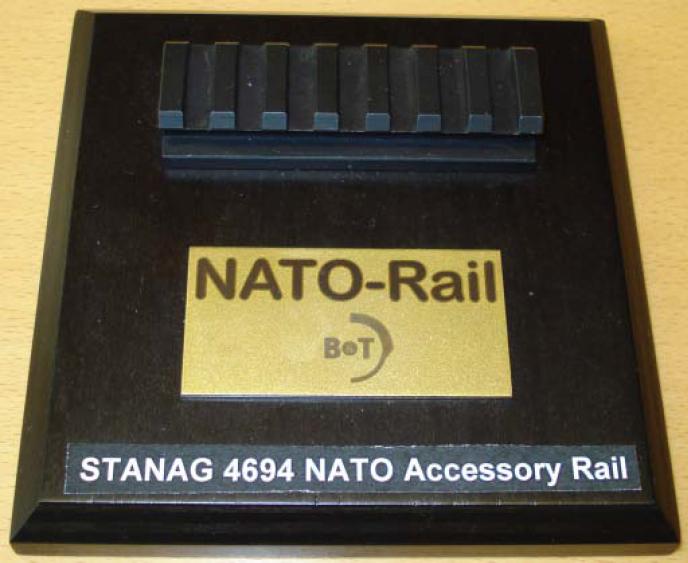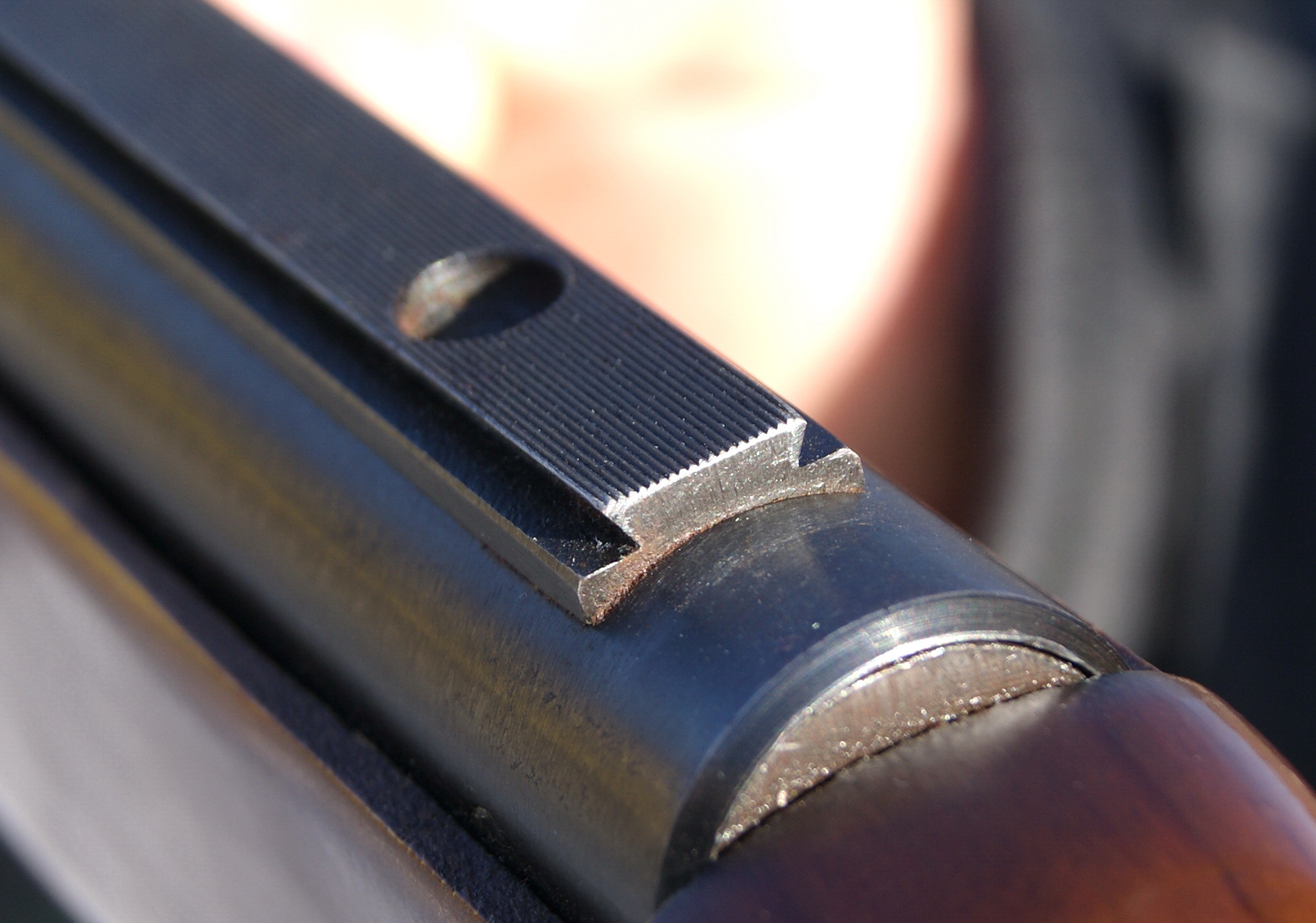|
NATO Accessory Rail
The NATO Accessory Rail (NAR), defined by NATO Standardization Agreement (STANAG) 4694, is a rail interface system standard for mounting accessory equipments such as telescopic sights, tactical lights, laser aiming modules, night vision devices, reflex sights, foregrips, bipods and bayonets to small arms such as rifles and pistols. STANAG 4694 was approved by the NATO Army Armaments Group (NAAG), Land Capability Group 1 Dismounted Soldier (LCG1-DS) in 2009. It was published in March 2011. The NATO Accessory Rail is backwards-compatible with the STANAG 2324/MIL-STD 1913 Picatinny rail, which dates back to 3 February 1995, and was designed in conjunction with weapon specialists like Aimpoint, Beretta, Colt Firearms, FN Herstal and Heckler & Koch. The Heckler & Koch G28 designated marksman rifle features NATO Accessory Rails. Technical specifications According to the NATO Army Armaments Group the differences between the MIL-STD 1913 Picatinny rail and the STANAG 4694 are: * A me ... [...More Info...] [...Related Items...] OR: [Wikipedia] [Google] [Baidu] |
STANAG 4694 “NATO Accessory Rail” 3
In NATO, a standardization agreement (STANAG, redundantly: STANAG agreement) defines processes, procedures, terms, and conditions for common military or technical procedures or equipment between the member countries of the alliance. Each NATO state ratifies a STANAG and implements it within its own military. The purpose is to provide common operational and administrative procedures and logistics, so one member nation's military may use the stores and support of another member's military. STANAGs also form the basis for technical interoperability between a wide variety of communication and information systems (CIS) essential for NATO and Allied operations. The Allied Data Publication 34 (ADatP-34) NATO Interoperability Standards and Profiles which is covered by STANAG 5524, maintains a catalogue of relevant information and communication technology standards. STANAGs are published in English and French, the two official languages of NATO, by the NATO Standardization Office in Bru ... [...More Info...] [...Related Items...] OR: [Wikipedia] [Google] [Baidu] |
FN Herstal
Fabrique Nationale Herstal (), trading as FN Herstal and often referred to as Fabrique Nationale or simply FN, is a leading firearms manufacturer based in Herstal, Belgium. It is currently the largest exporter of military small arms in Europe. FN Herstal is owned by the Herstal Group holding company, which is in turn owned by the regional government of Wallonia. The Herstal Group also owns the Browning Arms Company and the U.S. Repeating Arms Company (Winchester). FN America is the U.S. subsidiary of FN Herstal, which was formed by the merger of FN's previous two American subsidiaries – FN Manufacturing and FNH USA. A United Kingdom based manufacturing facility, FNH UK, is also in operation. Firearms designed and/or manufactured by FN include the Browning Hi-Power and Five-seven pistols, the FAL, FNC, F2000 and SCAR rifles, the P90 submachine gun, the M2 Browning, MAG, Minimi and the FN Evolys machine guns; all have been commercially successful.Miller, David (2001). ''T ... [...More Info...] [...Related Items...] OR: [Wikipedia] [Google] [Baidu] |
M-LOK
M-LOK, for Modular Lock, is a firearm rail interface system developed and patented by Magpul Industries. The license is free-of-charge, but subject to an approval process. M-LOK allows for direct accessory attachment onto the "negative space" (hollow slot) mounting points, and is a competing standard to VLTOR's open sourced KeyMod system for replacing the ubiquitous Picatinny rail in some applications. Compared to the Picatinny rail system, both M-LOK and KeyMod enable the user to have a slimmer, lighter, smoother and more fenestrated handguard/ fore-end with accessories mounted only where needed, whereas a Picatinny handguard typically will have rail slots for its whole length, resulting in a heavier and bulkier handguard with sharp edges and poorer barrel ventilation. The M-LOK system can be seen as an evolution of the Magpul Original Equipment (MOE) system, but the two are not fully compatible. Though newer M-LOK accessories can be used on older MOE slot handguar ... [...More Info...] [...Related Items...] OR: [Wikipedia] [Google] [Baidu] |
KeyMod
KeyMod is a universal interface system for firearm accessory components designed to supersede the MIL-STD-1913 accessory rails. The concept was first created by VLTOR Weapon Systems of Tucson, Arizona, and released through Noveske Rifleworks of Grants Pass, Oregon, before being published Open-source software, open sourced in the public domain for adoption by the entire firearms accessory industry. The name "KeyMod" was coined by Eric Kincel (then working for VLTOR Weapon Systems) following the naming trend of other VLTOR accessories with the suffix "Mod" meaning modular, and "Key" being a reference to the key-hole profile of the mounting slots. Description KeyMod is an open-source design released for use and distribution in the public domain in an effort to standardize universal attachment systems in the firearm accessories market. The KeyMod system is intended to be used as a direct attachment method for firearm accessories such as flash light mounts, laser modules, sights, scop ... [...More Info...] [...Related Items...] OR: [Wikipedia] [Google] [Baidu] |
Warsaw Pact Rail
A dovetail rail or dovetail mount can refer to several types of sliding rail system found on firearms primarily for mounting telescopic sights. Colloquially, the term ''dovetail rail'' usually refer to any straight mounting bracket with an inverted trapezoid (dovetail) cross-section (though the hexagonal-profiled Weaver rail and Picatinny rail are also derivative dovetail designs) running parallel to the bore for mounting a scope or diopter sight to a rifle. These are sometimes also called "tip-off" mounts, and allow the user to easily take on or off the sight. ''Dovetail mount'' can also refer to a dovetail track running perpendicular to the bore (see "Other uses" below). Dovetail rails for rifles Dovetails come in several different types and sizes depending on manufacturer, but the most common are the 11 mm and inch (9.5 mm). Some other less known, but currently commercially available dovetail mounts, are 12, 13, 13.5, 14, 14.5, 16, 16.5, 17 and 19 mm, a ... [...More Info...] [...Related Items...] OR: [Wikipedia] [Google] [Baidu] |
Scope Mount
Scope mounts are used to attach telescopic sights or other types of sights to firearms. The scope sight itself is usually made for only one of two main types of mounts, which can be classified as ''scopes for ring mounts'' (for example a 30 mm tube) or ''scopes for rail mounts'' (like for example the Zeiss rail). Words such as ''mounts'' and ''bases'' are used somewhat loosely, and can refer to several different parts which are either used together or in place of each other as ways to mount optical sights to firearms. When it comes to the interface of the firearm itself, the Picatinny rail is one of the most widespread standard for new firearms as of 2020. While most scopes are made for being mounted either with a ''ring mount'' or a ''rail mount'', some sights have an integral mounting mechanism allowing them to be attached directly to the firearm, like for example an integrated Picatinny mount. In addition, there are many proprietary and brand-specific types of mounts that e ... [...More Info...] [...Related Items...] OR: [Wikipedia] [Google] [Baidu] |
Weaver Rail Mount
A Weaver rail mount is a system to connect telescopic sights (often via a scope mount) and other accessories to firearms and certain crossbows. It uses a pair of parallel rails and several slots perpendicular to these rails. The later Picatinny rail, developed by the US military, is a development of the key concepts of the Weaver system, and they are partially compatible. History The Weaver mount was developed by William Ralph Weaver (1905 – 8 November 1975) at his telescopic sight company W.R. Weaver Co., which he founded in 1930. Previous systems included the Leupold/Redfield mounts. Compared to the Leupold mount, the Weaver rail is not as strong and cannot be adjusted for windage. W.R. Weaver Co. became Weaver Optics, and was a subsidiary of Meade Instruments Corporation from 2002 to 2008, when it was on-sold to become part of Alliant Techsystems's Security and Sporting division in Onalaska, Wisconsin. Features Older Weaver systems used two pieces mounted a distance ... [...More Info...] [...Related Items...] OR: [Wikipedia] [Google] [Baidu] |
Firearm
A firearm is any type of gun designed to be readily carried and used by an individual. The term is legally defined further in different countries (see Legal definitions). The first firearms originated in 10th-century China, when bamboo tubes containing gunpowder and pellet projectiles were mounted on spears to make the portable fire lance, operable by a single person, which was later used effectively as a shock weapon in the Siege of De'an in 1132. In the 13th century, fire lance barrels were replaced with metal tubes and transformed into the metal-barreled hand cannon. The technology gradually spread throughout Eurasia during the 14th century. Older firearms typically used black powder as a propellant, but modern firearms use smokeless powder or other propellants. Most modern firearms (with the notable exception of smoothbore shotguns) have rifled barrels to impart spin to the projectile for improved flight stability. Modern firearms can be described by their caliber ( ... [...More Info...] [...Related Items...] OR: [Wikipedia] [Google] [Baidu] |
Rail System (firearms)
Rail systems on firearms are straight mounting brackets (usually made of strips of metal or polymer) on the gun's receiver, handguard or fore-end stock to allow sliding/variable-position attachment of Iron sights, Scopes , Holographic Sightsand other optical sights options. .Along with accessories such as tactical lights, laser sights, vertical/angled foregrips and/or bipods. Are examples of just a few options that may be used depending on a mission's need for the M4 is SOPMOD, amongst many other accessories like sling attachment points (which may be ether ring, loop and/or quick detach mounts using push button style hardware) to name just a few of the many options. An advantage with the multiple rail slots is the moveable positions to adjust for optimal placement of each item for each different user. Along with the ability to switch different items at different placements due to varying eye reliefs on gun sights, scopes & optics. Tactical usage and Shooting sports ... [...More Info...] [...Related Items...] OR: [Wikipedia] [Google] [Baidu] |
Repeatability
Repeatability or test–retest reliability is the closeness of the agreement between the results of successive measurements of the same measure, when carried out under the same conditions of measurement. In other words, the measurements are taken by a single person or instrument on the same item, under the same conditions, and in a short period of time. A less-than-perfect test–retest reliability causes test–retest variability. Such variability can be caused by, for example, intra-individual variability and inter-observer variability. A measurement may be said to be ''repeatable'' when this variation is smaller than a pre-determined acceptance criterion. Test–retest variability is practically used, for example, in medical monitoring of conditions. In these situations, there is often a predetermined "critical difference", and for differences in monitored values that are smaller than this critical difference, the possibility of variability as a sole cause of the difference ma ... [...More Info...] [...Related Items...] OR: [Wikipedia] [Google] [Baidu] |
Metric System
The metric system is a system of measurement that succeeded the Decimal, decimalised system based on the metre that had been introduced in French Revolution, France in the 1790s. The historical development of these systems culminated in the definition of the International System of Units (SI) in the mid-20th century, under the oversight of an international standards body. Adopting the metric system is known as ''metrication''. The historical evolution of metric systems has resulted in the recognition of several principles. Each of the fundamental dimensions of nature is expressed by a single base unit (measurement), base unit of measure. The definition of base units has increasingly been realisation (metrology), realised from natural principles, rather than by copies of physical artefacts. For quantities derived from the fundamental base units of the system, units SI derived unit, derived from the base units are used—e.g., the square metre is the derived unit for area, a qu ... [...More Info...] [...Related Items...] OR: [Wikipedia] [Google] [Baidu] |





